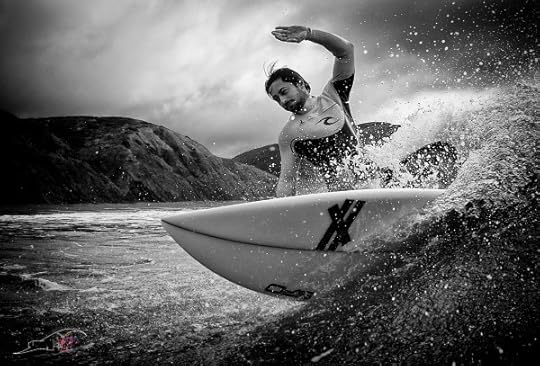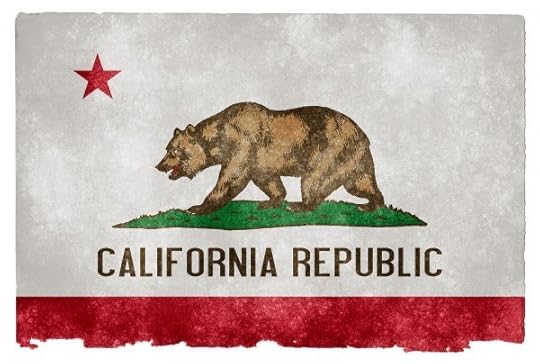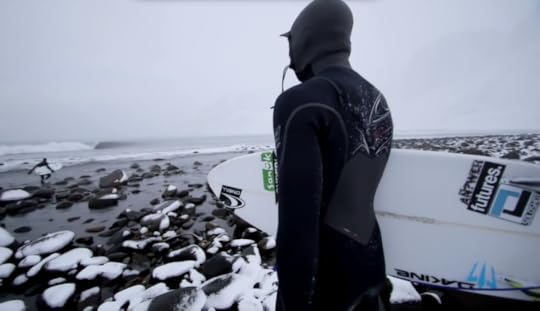Matador Network's Blog, page 2242
July 16, 2014
Learning to surf? Go to Portugal

Photo: Brendan Bank
1. The coastline is huge.
Portugal has nearly 1,800 kilometers of coastline, and there are beaches for surfing almost everywhere: from northern spots near Porto, to Ericeira, Nazaré, Peniche, Cascais, Costa da Caparica in the south, and some others in the Algarve. It doesn’t matter where you stay, because even if you have to drive two or three hours west, you’ll find a nice place to begin your surf experience.
2. The local sardines are the perfect food.
You probably hate them because your mother told you they were good for you. But give them another try now that you’re in Portugal. You’re older and wiser.
What you’ve eaten in the past is very different from the grilled sardines, sardinhas asadas, found during the Portuguese summer. They’re delicious; but the real difference is the experience of going into a small local restaurant and inhaling the fishy, fresh Atlantic Ocean aroma.
3. Southwestern Europe has awesome weather.
Europe in the summertime can be a gross, sweaty experience. But not in Portugal, where summer temperatures remain a pleasant 80°F. Autumn and spring bring averages of 60, while winter temperatures hover in the high 50s. Even if locals say, “Hey man, it’s chilly today,” you’ll be smiling and sweating tears of pleasure.
4. There are waves for everyone.
Summer (April to September) is the best time to learn how to surf. Along with warmer temperatures, summer also brings small-to-medium waves. Winter waves are bigger and should be reserved for those with more experience. As a beginner, best to plan your surf trip when the sun is high and the days are long for warm, safe fun.
5. You can check out the islands.
Some travelers seem to have “island fever,” and are only happy in small, isolated territories surrounded by millions of gallons of salt water and colorful marine life. Again, Portugal delivers.
The Azores and Madeira are pretty much as close to paradise as you’ll get in the middle of the Atlantic Ocean. You’ll find giant gardens with very rare species of plants, wild volcanoes, and some of the most beautiful beaches on Earth. They belong to Macaronesia, a collection of archipelagos in the North Atlantic Ocean, also known as “islands of the fortunate,” which is a good name for a place.
6. The cost of living is cheap.
Peniche, a fishing community 94km from Lisbon, is a great location to learn how to surf. You can stay for a week at Peniche Hostel Backpackers for less than 25 euros a night. They offer surf lessons and you can rent boards, wet suits, and other essential gear. There are fresh breads, fruits, and cereals for breakfast every morning, and you’ll make friends from all around the world who share your passion for surfing. In five days, you’ll surf over 20 hours and spend less than 300 euros.
7. Portugal always understands you.
Whatever your language situation, Portugal has an answer. If you don’t speak Portuguese, no problem. You can speak English, and locals will understand almost everywhere. If you don’t feel comfortable with English, you can survive on Spanish, too. Luckily, the Portuguese have a good ear for languages.
8. It’s a top surfing destination.
Mick Fanning, Kelly Slater, Adriano de Souza, Julian Wilson, Kai Otton…. Those are the most recent champions of the Rip Curl Pro Porturgal, a surfing World Championship Tour event, held every year around October at the Supertubes beach in Peniche.
And have you heard about the biggest wave ever ridden? February, 2014. Nazaré, Portugal. A British big-wave surfer named Andrew Cotton caught it. 70-80ft monster waves were pumping one after another offshore, just a few kilometers from your little beachbreak full of rookies. 

Brazil is a nation defined by soccer
The World Cup has ended and, as we’re all aware, the Germans won. Don’t tell me you didn’t see it coming!
Of course, as a Brazilian, I’ve seen better days. And those days are what the short film above, crafted by British agency Mother London, is all about. Pentacampeão (meaning “five-time champion”) uses footage from the five times Brazil won the World Cup (1958, 1962, 1970, 1994, 2002) and reaches out to soccer fans on Brazilian streets to try and answer this question: Why does the country take soccer so seriously?
It spans from the shock of 1950’s “Maracanaço” (when Brazil, absolute favorite, lost the final game to Uruguay at the nation’s soccer temple, Maracanã Stadium) to the energetic 2002 victory orchestrated by Ronaldo and company, touching on Brazil’s celebratory nature and desire to be recognized as links between the country’s sport and its people. The soundtrack is gorgeous, and most of the talk in the short (12-minute) documentary takes place at soccer fields and bar tables. As Brazilian as can be.
I’m sure someone out there is already planning a short film about the historic 7-1 goleada Brazil suffered in the semifinal against Germany. But I’ll stick with this one. After all, we’re still the only five-time champion in the world! 

The naked bookseller of Quartzsite

Image via
I pull off Quartzsite’s main drag into the gritty parking lot of Reader’s Oasis Bookstore. Quartzsite is a tiny Arizona town in tough desert 125 miles from the even tougher city of Phoenix. Reader’s Oasis is a metal shed, a half dozen tables, a tiny desert garden, and a porta-potty in which a teddy bear poster tells us Bear Behinds are welcome…
…as are fronts. The gray-haired man who greets me wears a broad-brimmed leather hat, velour t-shirt, a barely there paisley thong. He waves as I climb out of my truck. It is clear he is not about to give me that cheery Sales Associate “Can I help you?” His smile is real and weathered as his skin.
“I’m Paul,” he says. “You must be Mary.”
“I must be,” I say and look down at my salsa-splotched jeans. “It’s a good thing,” I say, “I dressed formal.”
“You’re fine,” he says — and I am. I can’t think of anywhere I would rather be on a soft February day than sitting at an oilcloth-covered table in the hardscrabble heart of Quartzsite, the snowbird town that goes in winter from a few thousand people to 125,000.
Paul sets two pans of home-baked cake in front of me, says, “We always provide refreshments for book signings,” and wanders off to check in used books. I wait in the perfect sun. I know that even if no one shows, I’m a success.
Four hours later, I’ve sold three books, given away one, and bartered another for six grapefruits and four tangelos from Norman Wood’s 10-acre orchard. He is a regular customer, a tiny 90-year-old man, dressed in overalls with red suspender straps.
By the time the Mohave light goes soft blue, I have talked for an hour with an old Montana rancher down for the winter. His little Pomeranian stands in the open truck window. The dog has one eye, and when I ask the rancher why, he says, “Why, she was talking when she should have been listening. A big mutt took her whole head into his mouth.”
His tired eyes light up as he tells me he’s a flint knapper. “Yep, I wanted to learn something new while I could. You know what I mean? Our age, we don’t have forever.”
I tell him I do know what he means. That’s why I’m signing books at Reader’s Oasis. That’s why I stopped the night before at Burro Jim Motel in Aguila, and ate at a local Mexican restaurant where I gobbled the best homemade corn tortillas you’d never taste in a chain.
By the time I leave, the bookstore owner and I have bartered stories for stories. We’ve traded grace for grace, his face gentle as he listens to my rant against rich fifth-wheel tourists. “You’re right about some of them,” he says, “but you’re wrong about the people here. Most of the folks who come here are blue-collar retirees. They’ve sold everything to buy that rig, and it’s their future. They hope they can sell it when being on the road gets too rough and they have to go back to landlocked life.”
He shakes his head. “You learn a lot loving a place like this.”
The last bronze of the sunset glitters in the dust as the rancher pulls away. I pack up books, grapefruit, and tangelos — and the new story I will carry home, on a desert two-lane that will take me north, past a town named Brenda, a crossroads named Hope. 

Should Cali split into 6 states?

Photo: Nicolas Raymond
Silicon Valley venture capitalist and multibillionaire Tim Draper (who also goes by “Riskmaster” apparently) believes that California should be split into six separately governed states. These proposed states would have refreshing new names like: “Central California!” “Western California!” Even “Northern California!” There would not be an “Eastern California!” however — that would be too excessive. And of course, “Silicon Valley” would be a free agent as well.
Draper has successfully collected 1.3 million signatures, enough to put his proposal on the 2016 ballot if the federal government signs off on it. Which Washington Post reporter Philip Bump believes, “it will never do, because, come on.”
Each state would have its own tax system, water supply, and California would go from just two senators in Congress to 12. The Washington Post has a breakdown here of what these proposed states would look like in terms of wealth, poverty level, racial make-up, etc. Basically, Silicon Valley would be the richest powerhouse of the six. Go figure.
Draper states in his proposal that present-day California is ungovernable. And “vast parts of [the state] are poorly served by a representative government dominated by a large number of elected representatives from a small part…both geographically and economically.”
Proposals like these are nothing new to California, a state which, Draper points out, is “nearly 6 times larger than the average population of the 50 states.” Attempts have failed in the past, but Draper has a lot of money. 
What do you think? Would six Californias be better than just one?

6 needs of the Millennial traveler

Photo: Helga Weber
THE WAY I TRAVELED as an 18-year-old college student is not the same way I travel as a 27-year-old full-time writer. The one aspect my two selves have in common is that we are of the Millennial generation, categorized as people currently between the ages of 16 and 34, or anyone born after 1980.
Our parents were lured in by exotic vacations packaged neatly by travel agents that would accommodate their two-weeks’ paid time off from their jobs. But with an unemployment rate that’s still dogging many of us in the US, Millennials don’t have the income to justify those kinds of experiences. We’ve gotten creative with our lack of funds and non-structured time off. Our needs as travelers have changed as a result.
It may be true that most travelers are looking for some, or all, of the aspects listed below. And not all Millennials fit the mold. But from interacting with new travelers on a daily basis — as well as analyzing my own behaviors abroad — these are the desires I’ve noted when it comes to the next generation of traveler.
1. Constant connection
The #1 request on any Millennial traveler’s wishlist is for the world to offer free wifi, everywhere. We base our choices on how many outlets a hotel has, which airlines have in-flight entertainment, and which attractions are the most Instagram-worthy. We desire to be constantly connected to the outside world, and in real-time. We’ve also managed to maintain long-distance friendships with people we’ve met along the way much more easily than previous generations ever did.
2. Comforts of home
We don’t want to know we’re sleeping in a hotel — we want our accommodations to feel familiar. We like hunkering down at “broken-in” spaces — a la AirBnB and, to a lesser extent, CouchSurfing — where we come “home,” greeted by roommates, or to a quiet space just for us. We don’t want to be bothered by housekeeping knocks at 8am, or inconvenient check-in times. We would rather rent an apartment for a month than stay in a hotel for two weeks. We enjoy feeling like we’re a part of the community, and are more likely to accept a homestay as an option.
3. Authenticity and personal experience
We are driven by the emotional connection of travel. We want to see the Eiffel Tower, but only as a Parisian would see it. We want to eat pasta in Italy, but help make it fresh in the kitchen of a Sicilian grandmother. We choose to sit in trendy cafes for hours, surrounded by locals and unfamiliar languages, rather than pack our trip itineraries with must-see attractions. We are all right with taking a week to drive across the USA, because we know it will result in life-changing personal experiences.
4. Low-cost luxury
This is a given for most types of travelers, but especially for Millennials. We don’t have the income to drop $500 a night on a hotel room, but we still want to feel on top of the world. Our definition of luxury has changed as well. For us, luxury equates to a feeling of ease and low-stress — a taxi ride from the airport instead of using public transportation, or a glass of wine at dinner that isn’t the cheapest on the list. We revel in simple touches that aren’t part of our daily routine: designer bath products, complimentary Fiji water, in-flight amenities kits.
5. Independence and permission to explore
Millennials are plotting their own course in every aspect of life — their travel experiences are no different. The next generation of traveler is not looking for a guided or group-tour experience. We want to see the world our way, free of tour managers, of admission tickets, of guidebook recommendations. We don’t want to be tethered to a large group, be constricted by a detailed itinerary, or sit on a tour bus for half a day. We are renting cars for easy stop-and-go, collecting our meals from local markets, and soliciting suggestions from social media, as we need them.
6. Style, and a connection to the creative world
Part of the hostel appeal is that the spaces are decorated in unique, inviting ways. We look for rooms that have been designed by famous artists, or restaurants with signature dishes featuring locally harvested ingredients. We favor catching a live jazz ensemble we’ve never heard of at an underground club in Prague over an evening at the Moulin Rogue. Our souvenirs include handicrafts, fashion, and utilitarian wares that were designed within the local area. 

A 9-step guide to becoming Mongolian

Photo: Jargalsaikhan Dorjnamjil
1. Barbecue with a blowtorch.
Throw your favorite meat on the ground, light up, take aim, and let the flames fly. Mongolians love a good outdoor barbecue. Boodog, a Mongolian favorite, involves stuffing a goat full of potatoes, carrots, and hot stones, sewing it back up, throwing it on an open fire, and slowly roasting it with your handheld flame thrower. The result is a tender, slow-cooked, roasted delicacy.
2. Make your home completely portable.
Mongolia is one of the last places on the planet that still has a society made up of nomads. The ger, which translates simply to “home” in Mongolian, is the same yurt dwelling that Mongolians have used for centuries. Even Genghis Khan lived in one. The circular structure, made of wooden lattice and sheep felt, can typically be taken down or put up within an hour.
Strap it to your trusty horse or camel and ride off to follow your grazing livestock to the next hidden valley of wild grasses.
3. Use literal horsepower.
There aren’t many places left in the world where, when someone needs to pick up some groceries, their preferred mode of transport is a horse. Children learn to ride almost as soon as they learn to walk. The herding nomadic lifestyle that comprises the majority of the country’s livelihood means that many Mongolians spend countless hours on horseback.
Only when you can gallop up to your local bank, tether your steed outside, and step in to make a deposit will you truly be counted as one of the people of the Great Khan.
4. Embrace the great wide open.
City streets, tall skyscrapers, and bustling sidewalks aren’t the norm in Mongolia. You need space for your horses to run, your livestock to graze, and your children to play. Mongolia is the largest country with the least number of people (ranked 135th in world). The landscape is wide rolling steppes, expansive grasslands, vast desert, and rocky mountains. Lots of space and not a lot of people means plenty of room to run around and stretch those booted feet.
5. Make things out of milk.
If you’re a true-blue Mongolian, your diet consists of two staples: meat and dairy. Milk is not only sustenance, but a revered spiritual liquid symbolizing purity, renewal, and birth. And it doesn’t just come from cows, but also goats, horses, and camels. If you’re up to the Mongol challenge, you can turn that milk into anything. From curds to yogurts, cheeses to sweets, Mongolians cultivate the milk they get from their livestock to produce an array of products that would make the lactose intolerant clench their stomach.
For the bold, try a big bowl of airag, the Mongolian national drink of fermented mares’ milk. After several sour, nose-crinkling swigs, you’ll be tipsy and heading for the outhouse.
6. Have eagles do your bidding.
For clarification, your pet is an eagle. It is trained to hunt other people’s pets. If that isn’t badass, I don’t know what is. For centuries, Mongolians have tamed and used these birds of prey to hunt small game. In the far western province of Bayan Ulgii, Mongolian and ethnic Kazakhs still practice the art of sending their trained golden eagles out over the mountains and steppes, catching and retrieving rabbits, marmots, and foxes. The warm pelts from the animals are used to craft hats, gloves, and boots that help combat the brutal Mongolian winters.
7. Picnic like you mean it.
It can get pretty cramped in all those gers. Communal eating outdoors is one of the best ways to get together with large groups of people. Family and friends gather around a rug placed on the wide open steppe. Candy, veggies, vats of roast meat, and plates of bread and cheese are all spread out for everyone to enjoy. Older folks play games like dominoes and cards while the younger, strapping lads brush up on their wrestling techniques. Don’t forget to do your celebratory vodka shots. Lots and lots of vodka shots…
8. Become an expert fire starter.
Mongolia is known for its long, grueling winters, with temperatures plummeting well below -45°C. Mongolians must keep a constant fire going in their ger stoves to survive the winter. It can snow as early as August and the thaw may not hit until around May.
With all that open grassland, slow-burning fuel can be hard to come by. When wood and coal aren’t readily available, Mongols keep their ger toasty warm by collecting the dry dung from their livestock. When you can start your first bonafide poop fire, you’ve reached a level of fire-making prowess that would make Bear Grylls tip his hat.
9. Practice the three manly sports.
Naadam is the multi-day summer celebration commonly known as the Festival of the Three Manly Sports. Know them and embrace them. The sports — wrestling, horseback riding, and archery — are usually held over a three-day period in July in a series of nonstop competitions. The festival harks back to the time of Genghis Khan, when Mongol warriors would compete against each other while laying siege to the cities of their enemies.
Wrestling is done in a small ring where the winner is the first man to throw his opponent to the ground. Families spend years breeding the fastest horse for the horse race portion, and children are usually chosen as riders for their light weight. The most accurate and strong-armed archers are chosen to compete, and usually spend the last day of the festival firing volleys into far-flung targets. Practice up! 

July 15, 2014
On moving from Kentucky to Australia

Photo: Stoofstraat
1. Kentuckians are nicer than Australians.
In Kentucky, everybody is always friendly no matter what. It’s almost as if people trip over themselves to say hello, or call you “partner,” or hold the door for you. In Australia, it seem like the reverse is true. You’ll get a lot more icy stares and avoiding eyes. The meaner friends are to you, the more they like you (“taking the piss”).
Kentuckians live by the old adage, “If you can’t say anything nice, then don’t say anything at all.” Aussies are happy to shit all over your weaknesses.
2. A Kentuckian takes 30 words to say something an Aussie can say in one.
Kentuckians spend hours and hours talking. Whether it’s in line at the post office or at the grocery store, it’s a contest for who can tell the longest story. A completely uneventful trip to grandma’s can be retold for three hours.
Aussies are famed for being laconic. Every single word gets shortened. Even though it has the same number of syllables, breakfast has to be “brekkie.”
3. Kentuckians eat like shit.
In Kentucky, people believe that authenticity can be bought and bought for cheap. Want authentic Italian? Head down to the drive-thru, where a “real” Italian meal is $5. And it comes with a five-megalitre plastic cup of Coke. Are you a parent with a picky eater? No problem! You can choose from an array of frozen mini corn dogs and pizza chips. Or what the hell, just feed your precious little darling some popcorn and chocolate cake for dinner.
Plenty of Aussies eat junk food, and McDonald’s (Macca’s) is quite popular, but the average Australian has a better grasp of the five basic food groups. An Aussie understands that a salad tastes better when it doesn’t come in a plastic container. And apples don’t need to be pre-sliced for convenience.
4. Kentuckians like the idea of being outdoors, but not actually being outdoors.
Kentuckians like to believe they are master outdoorsmen. All the fish in the mighty river are there to be caught. Well, at least that’s what TV commercials and Saturday afternoon strolls around Bass Pro Shop tell them. In the big KY, “avid” hikers take early morning strolls around the shopping mall. Going “off-road” and “roughing it” means taking a NATO-tank-sized truck to the local McDonald’s drive-thru, and sitting in the parking lot while the kids watch Scooby-Doo in the backseat.
In Australia, basic campfire knowledge is a necessity. When you find a snake in your house, you know how to take care of it. In Kentucky, you call someone to come take care of it.
5. Kentuckians believe in freedom; Australians believe in paying for freedom.
The cost of living is exceedingly cheap in Kentucky. Houses start at $40,000 and include public access to tennis courts, basketball courts, and Frisbee golf. While watching the bug-zapper may constitute the nightlife, there are plenty of free and healthy things to occupy your time during the day. Don’t even get me started on the beer. Such a wide array of beautiful craft brews all at your fingertips. And cheap!
Australians love to heap shit on our capitalist ways in the north. But down under you have to pay to breathe. Literally. Every single thing costs money and a lot of it. Considering a modest house in Melbourne? Consider at least $600,000. Tennis? Fifteen bucks an hour. Basketball? You can play for free but there won’t be a net. And you might contract hepatitis from the rim. At least you can go out and reward yourself with a blueberry-infused oatmeal Black IPA. Ironically named Obama Beer. Price tag: $18 a bottle.
6. Sports — that’s something we can agree on.
Kentucky’s religion is college basketball (Kentucky or Louisville). Australia’s religion is footy (AFL or rugby). Both state and country follow their religion with the utmost devotion. 

Surfing the Arctic
Since 2008, Matador Ambassador Chris Burkard has been pioneering surf photography in the Arctic. Arctic Swell, a new film produced by Smugmug, documents Burkard’s latest mission to Unstad, a bay in the Norwegian archipelago of Lofoten just inside the Arctic Circle.
Burkard’s crew, which included surfers Patrick Millen, Brett Barley, and Chadd Konig, had to take three flights, a ferry, and drive several hours to reach the surf. They traveled in early March, with temperatures hovering around five degrees, sometimes dipping below zero. Burkard notes, “Some people think I am crazy for wanting to go that time of year, but it’s when the northern lights are brightest and the surf gets epic!”
Besides showing how perfect conditions can be found and ridden in one of the harshest environments on earth, Arctic Swell is a look behind the lens at Chris Burkard, whose voiceover gives a lot of insight into his motivations as a photographer. “It’s not even the most beautiful images,” he says, “but the ones where you think, ‘I really gave something of myself to get that shot.’” 


Paragliding with vultures [vid]
Vultures don’t have the best reputation — they are carrion birds, and as such, are mostly known for eating dead or dying things, and also for puking on things as a defense mechanism. These obviously aren’t the most appealing traits from a human’s perspective, but that doesn’t mean vultures are any less important to their ecosystem.
Kerri Wolter is a conservationist who works with Cape vultures in South Africa, and in order to understand them better, she paraglides with them. The views in the video above are absolutely spectacular, and you can start to get a sense of vultures aside from the whole puking and eating corpses thing.
Check out the Vulture Conservation Project to learn more. 

The moral cost of travel

Photo: Maeka Alexis
It was in Paradise Lost that John Milton introduced the notion that Adam and Eve ate an apple from the tree of knowledge (thus explaining why your “knowledgeable” elementary school teachers may have had the infamous symbol sitting on their desks). The writers of Genesis left the forbidden fruit unspecified, but scholars have since claimed it could’ve been a grape, possibly a fig, even a pomegranate. Whatever it was exactly, the first Biblical book is clear that its consumption was the ultimate sin — and ever since the Western world has equated knowledge with a loss of innocence. Banned from Eden, the original sinners were also the original knowledge seekers, and the idea that understanding means corruption is widespread, often seen in dubious platitudes like “ignorance is bliss.”
Throughout history, innocence has been lost when new knowledge is gained, and the most common way for that to happen is by leaving home. By temporarily or permanently saying goodbye to what she knows best, the traveler willfully treks out from the light into the dark, plucking an apple from the tree of knowledge on her way.
The realm of the unknown is perhaps humankind’s greatest fear, but as the philosopher Spinoza said, “There can be no hope without fear, and no fear without hope.” To travel is to hope, but it’s also to confront one’s fears. To stay in your tiny corner of the globe is to stay ignorant, and, indeed, it can be blissful. Yet what a warped perspective this blind contentment gives. Prejudices and naïve thoughts bask in restfulness and immobility.
Travel can inadvertently cause people to become scared of the world.
The first time I left the United States, I went to Romania, Hungary, and Moldova, where my family did charity work in orphanages and hospitals with a local organization. At the time, there was a travel alert from the US government cautioning Americans not to go to Moldova. No one in my family spoke Romanian or Hungarian, nor did we have any relationship with those countries. The reason we traveled there — going against our own government’s wishes — was straightforward to my parents: My brother and I needed to see a harsher side of the world. Budapest and Bucharest are essentially first-world cities, but the rural areas where we worked, mainly populated by Roma, were derelict and, at least from the perspective of a middle-class American, dangerous.
Later, my brother and I were taken to Athens at a time that coincided with the riots of the extremist Golden Dawn party, where we witnessed a great deal of violence. And, for every spring vacation in high school, we were taken to politically tumultuous areas of the world, like Tijuana, Mexico, where drug cartels still maintain a strong presence, and to Skid Row in Los Angeles, a struggling downtown area infamous for its drug addicts and prostitutes.
While their friends back home applauded my parents for showing my brother and me the harsher sides of the world early on, there are serious questions about travel at stake. How much innocence should be preserved in children? How does white privilege and “poverty tourism” factor into the decision to travel? Should we take traveling so lightly? How much power does travel really have?
To explore these questions, I think it’s necessary to point out that there are two ways to travel: for pleasure or for understanding. Sauntering down, say, the Promenade de la Croisette in Cannes, stopping to shop at a boutique, and sunbathing on a particularly sun-filled patch of beach is a “pleasurable” way of traveling. Travel for “understanding,” however, would be to perhaps explore Africa’s longest coastline in Somalia, to climb Mount Everest, or to visit politically turbulent cities. Traveling for “understanding” entails neither easy nor safe pursuits, but one would presume they have the greater potential for enlightenment.
Yet the idea that exposure to danger allows for a more complex understanding of the world is a fallacy. The world in which we live has danger at every turn, even in seemingly safe places. Myanmar, whose tourism office seems to have unlimited funds (I feel I see an advert in every magazine), is a country that’s still a thinly veiled dictatorship. The picturesque, seemingly stable Christchurch, New Zealand, was flattened by an unexpected earthquake not so long ago. Even tried-and-true locales like the beaches of Waikiki or the museums of Paris are subject to pickpockets and thieves. To leave home is to expose yourself to the unknown no matter where you go.
More importantly, every time we travel, we’re transformed, so it doesn’t matter so much where we go — if it’s somewhere as dangerous as Afghanistan or as safe as the Amalfi Coast — it simply matters that we go at all.
A loss of innocence is usually depicted in popular culture as occurring after a tragedy, perhaps a first sexual encounter, or any time someone must undertake responsibilities disproportionate to their age and experience. Although the etymology is sometimes challenged, many believe the word “innocent” comes from the Latin noscere, meaning “to know” or “to learn” (the prefix in- meaning “not”). “Innocence” is to “not know” or “not learn.” When one travels, especially to places like riotous Greece, inner-city Los Angeles, or off-limits Moldova, one learns, and thus loses innocence.
Of course there’s nothing inherently immoral or wrong about traveling. In fact, a recent multi-million-dollar research campaign called Travel Effect found a litany of reasons why traveling is a healthy activity. Among other benefits it reported are these: that students who study abroad tend to have higher lifelong incomes, that one-third of leisure travelers have more sex while traveling, and that workers report slightly higher productivity and morale when given time to travel.
There’s something to be said for sheltering young people from the transformations that result from travel.
These are all respectable reasons to travel, but often we look only at the positive side. We enjoy fetishizing travel as the romantic pastime of the freethinker and wandering soul, but it’s also an incredibly formative, powerful, and far more jarring pursuit than it’s often given credit for.
Globetrotting guru Anthony Bourdain admitted that his passion for travel led to falling out of love with and eventually divorcing his first wife, Nancy Putkoski. He explained it by saying, “I knew that [travel] had changed me, altered the way I would look at things. And the first time I went back to America, I found I was right. Everything was flat. Everything.”
The perspective-altering effects of travel are common — in fact, they’re what many people like most about leaving home. But these effects can also lead to relationship failures, disappointment with careers, a change or loss of ideology, and an irreversible loss of innocence. Indeed, travel sleeps close to corruption.
I do believe my brother and I are better off having traveled to developing nations and politically unstable areas despite our young age. But often, travel, even to more typical destinations with the idea of ‘gaining new perspectives,’ can inadvertently cause people to become scared of the world. A traveler can clam up and fall out of love with both his home, which is now dull and tamed, and with the world, which is too different and unpredictable. Travel is still a worthwhile experience, of course, but loss of innocence and disenchantment with the world are high potential costs to pay.
Near the end of J. D. Salinger’s The Catcher in the Rye, the protagonist Holden Caulfield tells his little sister, Phoebe, that when he grows up he wants to be a “catcher in the rye.” Taking a cue from Robert Burns’ poetry, Holden says, “I have to catch everybody if they start to go over the cliff — I mean if they’re running and they don’t look where they’re going I have to come out from somewhere and catch them. That’s all I’d do all day.” Saving people from maturation, from a loss of innocence, is an honorable quest, and there’s something to be said for sheltering young people from the transformations that result from travel.
And yet, in the words of Holden describing his sister riding a carousel, “The thing with kids is, if they want to grab for the gold ring, you have to let them do it, and not say anything. If they fall off, they fall off.” As much as the god of Genesis wanted to be a catcher in the rye for Adam and Eve, they still decided to plunge over the cliff into a world of knowledge and adulthood. To go to Gypsy camps, to experience extremist politics in Greece, to be thrown into the middle of a drug cartel’s stronghold, indeed to leave home and travel at all — these pursuits only help one grow up faster. The decision to travel is simply to choose to grow up quickly. And just like you can’t return an apple to its tree, once you begin to explore the world, there’s no going back. 
This post originally appeared at delistraty.com and is republished here with permission.

Matador Network's Blog
- Matador Network's profile
- 6 followers




